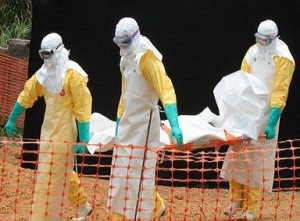 I read a recent article by Mike Adams at Natural News that asked Why Does the CDC own a patent on Ebola invention? Why indeed!
I read a recent article by Mike Adams at Natural News that asked Why Does the CDC own a patent on Ebola invention? Why indeed!
According to Adams, the CDC patent, awarded in 2010, is on a particular strain of Ebola known as “EboBun.” The patent summary says that “the invention provides the isolated human Ebola (hEbola) viruses denoted as Bundibugyo isolated from patients suffering from hemorrhagic fever in a recent outbreak in Uganda.” The patent summary clearly states that the US government is claiming “ownership” over all Ebola viruses that share as little as 70% similarity with the Ebola it “invented,” and specifically claims patent protection on a method for propagating Ebola virus in host cells as well as treating infected hosts with vaccines.
As Adams points out, that while the CDC’s patent is partially focused on methods for screening and treating Ebola victims with drugs and/or vaccines, the patent also gives the federal government a monopoly over anything created to treat this deadly disease. And with a fatality rate of up to 90% this could prove to be very profitable to the government.
The genus Ebola-virus comprises 5 distinct subtypes: 1) the Bundibugyo virus the CDC claims to have invented; 2) the Zaire, 3) Sudan, 4) Tai Forest and 5) Reston-Ebola. The Bundibugyo, Zaire and Sudan subtypes have been associated with large outbreaks in Africa, documented through the handling of infected chimpanzees, gorillas, fruit bats, monkeys, forest antelope and porcupines found ill or dead. The disease is then spread through human-to-human transmission through broken skin, body fluids and indirectly through the environments contaminated with such fluids.
A milder strain of Ebola was found in monkeys and pigs in the Philippines after a 1989 incident at a research facility in Reston, Virginia. Monkeys housed in quarantine were found to be infected with the Reston subtype after at least four humans became infected. Additional outbreaks of the Reston subtype occurred between 1989 and 1996 in Texas, Pennsylvania, and Italy. None of the infected humans became ill. Genetic analysis of the Reston subtype suggested that the virus had been widely circulating in swine in the Philippines for years and was also detected in farmers who had been in contact with the infected pigs. And while the Reston subtype has not caused illness in humans, to date, it is possible that the virus could become more dangerous after passage through pigs because they are ideal hosts in which viruses can mix and mutate.
In 2012, Researchers at the University of Manitoba deliberately infected six piglets with the Ebola virus and put them in pens where macaque monkeys were housed in wire cages. Within eight days all four monkeys caught the virus through indirect contact, according to their study published in the journal Scientific Reports. According to the researchers, the “findings support the hypothesis that airborne transmission may contribute to spread, specifically from pigs to primates, and may need to be considered in assessing transmission from animals to humans in general.”
Dr. Gary Kobinger from the National Microbiology Laboratory at the Public Health Agency of Canada who took part in the study said that researchers “suspect that large droplets of moisture containing the virus were exhaled with the piglet’s breath. They can stay in the air, but not long, they don’t go far, but they can be absorbed in the airway and this is how the infection starts.
Ebola virus is a class A bioterrorism agent. The University of Manitoba research along with the discovery of the Reston subtype in pigs introduces the possibility of the transfer of Ebola virus to humans from pigs.
According to officials we don’t need to worry about Ebola spreading to the U.S. But is that true? They claim that Ebola won’t mutate because it kills its victims so quickly. Are they lying to us?
It can take up to three weeks for symptoms to show up. Anyone boarding a flight to the U.S. could easily come into contact with an infected individual that didn’t have symptoms and by the time anyone figured out they had been exposed, it is hard telling how many people could become infected.
According to a Purdue University science team’s research, Ebola may already be mutating. “It has a biochemical structure similar to retroviruses carried by birds, making a common evolutionary origin likely.” Professor David Sanders said that there is a genuine worry by scientists that Ebola is mutating and becoming airborne. “Recent outbreaks have suggested it can evolve on its own, and Ebola subtypes have shown the ability to be spread through airborne particles. . .”
The truth is, Ebola is one flight away from the U.S.

